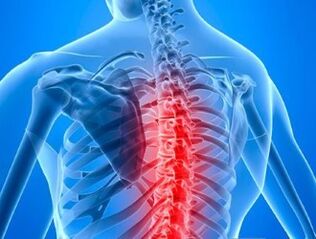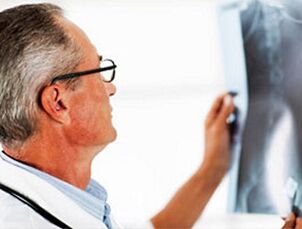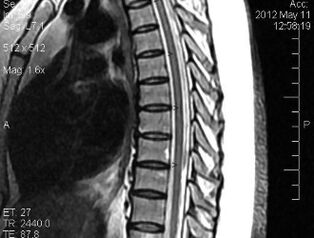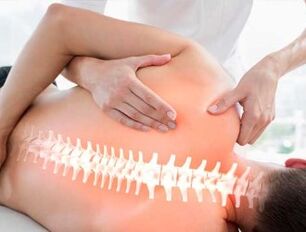
Osteochondrosisis a disease of modern society.
Hypodynamia, an unhealthy diet causes pathological changes in the spine.
Thorax osteochondrosis is far less common than in the cervix and lumbar.
This is due to the lower movement of this part of the spine.
According to the international classification of diseases (ICD 10), this disease has the code M42.
Pathological essence
Osteochondrosis of the thoracic spine is a dystrophic change in cartilage tissue and bone in the spinal space. The disease affects both sexes between 25 and 50 years of age. The disadvantage of this disease is that the symptoms "disguise" as a sign of another disease (cardiovascular or gastric), therefore, osteochondrosis of the chest is diagnosed late.
Disease development algorithm:
- Under the influence of adverse factors, the core of the vertebral disc becomes thinner and flatter.
- Adjacent vertebrae approach each other, an inflammatory focus arises between them.
- The joint capsule is stretched, the movement of the spine decreases.
- The roots of the spinal cord are pinched.
- The spinal cord is compressed.
- Vertebral bone tissue grows, bone processes (osteophytes) appear.
Four stages of disease are differentiated depending on the degree of vertebral lesion:
| Stage 1 | Changes in the vertebrae are not expressed, there are no obvious symptoms. At this stage, treatment gives a good effect: it is possible to restore damaged tissue. |
| Stage 2 | This stage is characterized by the appearance of microcrats on the spine, impaired movement. The vertebrae begin to shift from each other. Treatment requires a lot of effort and time. |
| Level 3 | The vertebral disc becomes thinner until a bulge and hernia appear. Mobility is reduced to a minimum. At this stage, nerves are pinched, the work of internal organs is disrupted. If you do not start treatment, this will lead to disability. |
| Level 4 | There is a complete thinning of the disc, impaired spinal function, the process of bone tissue destruction is underway. Neurological symptoms are pronounced. |
Thoracic osteochondrosis has a wavy character, i. e. , period of remission and exacerbation.
Reason
Until nowthe exact cause of this disease is unknown. In medicine, there are many theories on this subject, but none provide an accurate explanation as to why the process of spinal cartilage degeneration begins. The main "perpetrator" is admittedly walking upright.

Provoking factors are considered:
- Descendants.
- Congenital defects in spinal space.
- Infectious diseases.
- Obesity.
- Hypodynamics.
- Long stay in one position.
- An unbalanced diet, where there is a lack of vitamins and minerals.
- Back injury.
- Age-related changes.
- Great physical activity (during sports or work-related).
- Kaki rata.
- Pregnancy.
- Prolonged stress.
- Smoking.
As a result
If left untreated, the consequences of osteochondrosis can be catastrophic.Degenerative changes cause the appearance of spinal hernias. Nerve compressioncauses loss of sensation in the limbs. The most serious complication is paralysis of the arms or legs.
In addition,interferes with the work of all internal organs and systems: cardiovascular, urinary, digestive. Patients experience vegetative-vascular dystonia. The fact is that the spinal canal is compressed, the supply of oxygen to the brain is disrupted. Patients experience persistent headaches, panic attacks, sleep disturbances. Intercostal neuralgia is also a consequence of osteochondrosis.
Symptoms
The first symptom of this disease isfeeling tense in the back muscles. Then a dull ache in the back joined it. Other manifestations may be similar to the symptoms of other diseases, for this reason, thoracic degenerative disc disease is called "chameleon".
The main symptoms of this disease are:
- "goosebumps";
- chest pain;
- shooting pain between shoulder blades, especially when turning the body;
- dizziness;
- fainted;
- suppresses pain in the heart;
- swelling of the hands and feet;
- numbness in the hands;
- senak;
- decreased sexual function;
- short-term acute pain in the rib area;
- fatigue, decreased performance;
- general discomfort.
Diagnostics
A doctor can make a diagnosis by performing a thorough examination.
It is important to distinguish osteochondrosis from other diseases of the skeletal system, such as:
- rheumatoid arthritis;
- ostiomyelitis;
- spondylopathy.

It is also important to exclude diseases of internal organs:
- ischemia;
- heart attack;
- gastritis;
- stomach ulcers;
- pancreatitis;
- coral;
- pielonefritis;
- tumor.
Laboratory and instrumental methods used for diagnostics:
- Blood test. There was a slight increase in leukocytes and ESR.
- Blood tests for electrolytes. With osteochondrosis, serum calcium levels are reduced.
- General urine analysis.
- Blood biochemistry.
- X-ray of spinal space. Allows you to detect disc deformation, vertebral displacement, presence of hernias.
- MRI. With the help of layer-by-layer pictures, the degree of degenerative changes in the spine is determined.
- Myelography. This is an X-ray examination of the spine using contrast. Allows you to assess the state of blood flow in the spinal canal.
Treatment
Treatment of this disease is done on an outpatient basis. For this, conservative methods are used.Therapy focuses on:
- relieves pain;
- inflammation reduction;
- removal of nerve end compression;
- cartilage tissue recovery.
If the patient is in severe pain, it is necessary to give him a bed rest. With severe pain syndrome, novocaine blockade is performed. At the same time, the dropper is placed with a non-steroidal anti-inflammatory drug.
Methods of treatment of osteochondrosis
Medications include the following medications:
| Nonsteroidal anti-inflammatory drugs | Depending on the severity, the product can be used as an injection, tablet or ointment. |
| Pain Relievers | - |
| Relax muscle | Use if there is a spasm of the back muscles. |
| Chondroprotectors | Restores cartilage tissue. |
| Diuretics | Reduces edema. |
| Vitamin Group B | For general strengthening of the back muscles, spine and central nervous system |
In stages 3 and 4 of this disease, therapy is more serious. Hormone medications are prescribed.
Massageimproves back muscle tone, relieves pain.The following types of massage are used:
- classic;
- dotted;
- in cans.
Physiotherapyis prescribed at the level of remission, performed under expert supervision. This exercise aims to strengthen the muscle corset, increase spinal mobility, and relieve nerve root stress. Patient metabolism is improved.

Physiotherapyhas a good therapeutic effect, especially at levels 1-2. It is recommended to hold several courses in a year to prevent deterioration. They use magnetotherapy, laser exposure, ultrasound, electrophoresis.
Manual therapyis an irreplaceable method for the treatment of osteochondrosis. Blood circulation is restored, nutrition of spinal tissue is improved. Expert qualifications are very important.
Spinal tractionis a controversial method. Some doctors believe that this, in turn, worsens the patient's condition. The essence of traction is to increase the intervertebral space using special equipment. In any case, this method must be used with caution.
Acupuncture. The effect on the active point not only relieves pain, but also balances the psyche of the patient.
Following a Special Diet. Considering a decrease in animal fat diets, an increase in the amount of plant foods. Nutrition should be balanced to supply the body with vitamins and minerals.
The therapeutic effect is achieved by combining several treatments. Surgical treatment is very rare if there is no conservative treatment effect.
Prediction and prevention
The prognosis of the disease depends on the degree of spinal lesions.It is impossible to cure the disease completely at levels 2-4. Properly selected therapy can only relieve inflammation and stop the progression of the disease. With proper treatment, a degree of remission is achieved, which should be taken care of with preventive methods.
Prevention of osteochondrosis is:
- maintain a healthy lifestyle;
- adhere to proper nutrition;
- exclusion of excessive physical activity;
- avoid being in one position for a long time;
- weight loss;
- timely treatment of infectious diseases.
Conclusion
Osteochondrosis of the thoracic regionis a serious disease that "gets younger" every year. Due to the slightest movement of the spine at an early stage, the disease does not manifest itself.
Symptoms are not specific, so other internal organ pathology is suspected. It is important to make a differential diagnosis to make an accurate diagnosis and prescribe adequate treatment.
This disease is treated using conservative methods, used together. Surgery is very rare in the event of serious complications. Without proper treatment, the patient's internal organs are disrupted, and his quality of life deteriorates significantly.
Negative consequences can be avoided with the help of properly selected therapies and adherence to preventive measures.

















































